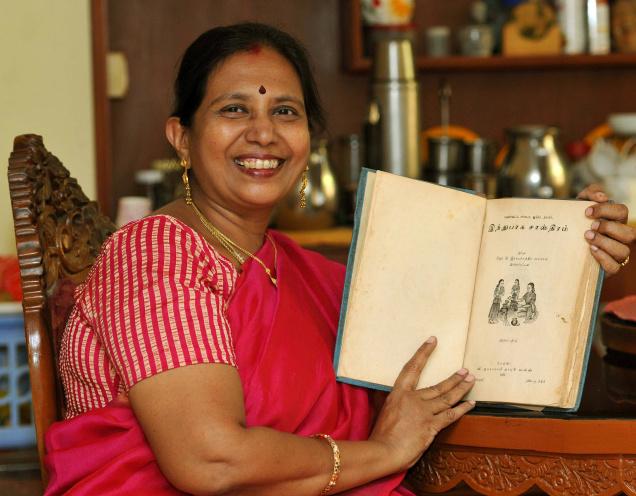
Geeta Padmanabhan finds, what she is convinced, is the oldest Tamil cookbook ever published
In early 2004, S. Muthiah featured a book in his Miscellany column. He wrote: “First published in Madras in January 1891, Maharashtra, Karnataka, Andhra and Dravida Hindu Pakasastra is a ‘treatise on Hindu vegetarian cookery in Tamil’ by T.K. Ramachandra Rau.” He referred to an enlarged version, the ‘third and Coronation edition’, marking the 1912 Coronation of ‘King Emperor George V & Queen-Empress Mary’. The preface of this book said the 2000 copies printed in 1891 were sold out. A second edition came out in 1900.
Celebrity cook Mallika Badrinath has the fifth edition of Hindu Pakasastra. It belonged to a K. Janaki in 1936, but was gifted to Mallika in 2002 by a Mrs. Radha Ramnath Dore. “Ms. Dore believed I would appreciate the book,” said a beaming Mallika, adding, “Please handle it carefully.” Her concern was about the discoloured pages, but the book is well-bound and the paper looks strong. Published by C Kumarasamy Naidu Sons in 1935 at the Caxton Press, this large 348-page recipe book cost Rs. 2 and 4 annas. What is that in today’s rupee value?
The book is priceless, particularly for its data on ingredients, cooking systems and recipes. For Rayar (Rau), cooking is a sacred art and science, and a cookbook, more than a simple collection of recipes. So you have a comprehensive textbook dealing with all aspects of Pakasastram: you learn of body types, appetite, tastes, health, nutrition, names/nutritive values of ingredients, cooking tools, fuels, weights/measures and meal plans before you reach the recipes. Rayar even talks of the kind of water you need to cook with! He meant this to be a beginners’ manual: ‘Training the Cook’ is a separate chapter. You master the book, and can walk into the kitchen with confidence to “feed — on all occasions — persons varying in number from 5 to 1000”.
“You are what you eat,” argues Rayar, linking food to satva, rajas, tamas and their combinations. He enlightens you on dietetic fibre, the six tastes and choosing a diet to suit your metabolism. (Prone to queasiness and heartburn? You run on ‘pitha’ metabolism. Stay away from cigarettes, alcohol, cluster beans, peerkangai, peanuts, green gram, til). He teaches you how to separate butter and make ghee, and tells you which veggies can be grilled on an open fire. He lists cooking methods with examples. Pictures of cooking implements enliven the pages. And ah, the recipes. Who said “Saadam” is rice or daliya? Try corn or one of the millet varieties (bajra, sorghum). Have you heard of, tasted or tried, kamir roti, chameli kushka (jasmine-scented rice), wheat and almond roti, gomati anar rice, vegetable doria, arbi (seppankizhangu) combos, tamarind-jaggery rasam, gooseberry payasam, onion sweet-dish, wheat-channa dal jilebi and red pumpkin/banana poli? These are among varieties of curries, koottus, raitas, chutneys, sweets and savouries that fill pages. It is a tremendous collection — a pot you can keep dipping into. The style is simple, as is the cooking. Recipes call for very few spices; the emphasis is on bringing out the taste of the vegetables. Onions and garlic are sparingly used.
You get a description of tea/coffee/cocoa before reading how to prepare drinks out of them. He uses a picture of a plantain leaf to tutor you on where the dishes are placed. Tables estimate measures and costs of provisions for different clusters of guests.
Pakasastram is more than a record of our rich culinary tradition; it is a peep into our political/social/economic history. Rayar refers to the growing trend of men going abroad to earn, and acknowledges Queen Victoria’s efforts to open schools for girls.
It is, in its attempt to answer the question, “why should you learn cooking?” that this remarkable tome makes me squirm. The book is a lecture addressed to two young girls, so Rayar’s message is for women. “Proficiency in cooking is of foremost importance to carry out your duties of looking after the husband, children and others,” he writes. Ahem.
Hindu Pakasastra may well be the first published cookery book in Tamil. I am willing to bet on it till new information is unearthed.
source: http://www.thehindu.com / The Hindu / Home> Features> MetroPlus> Food / by Geeta Padmanabhan / Chennai – September 11th, 2015